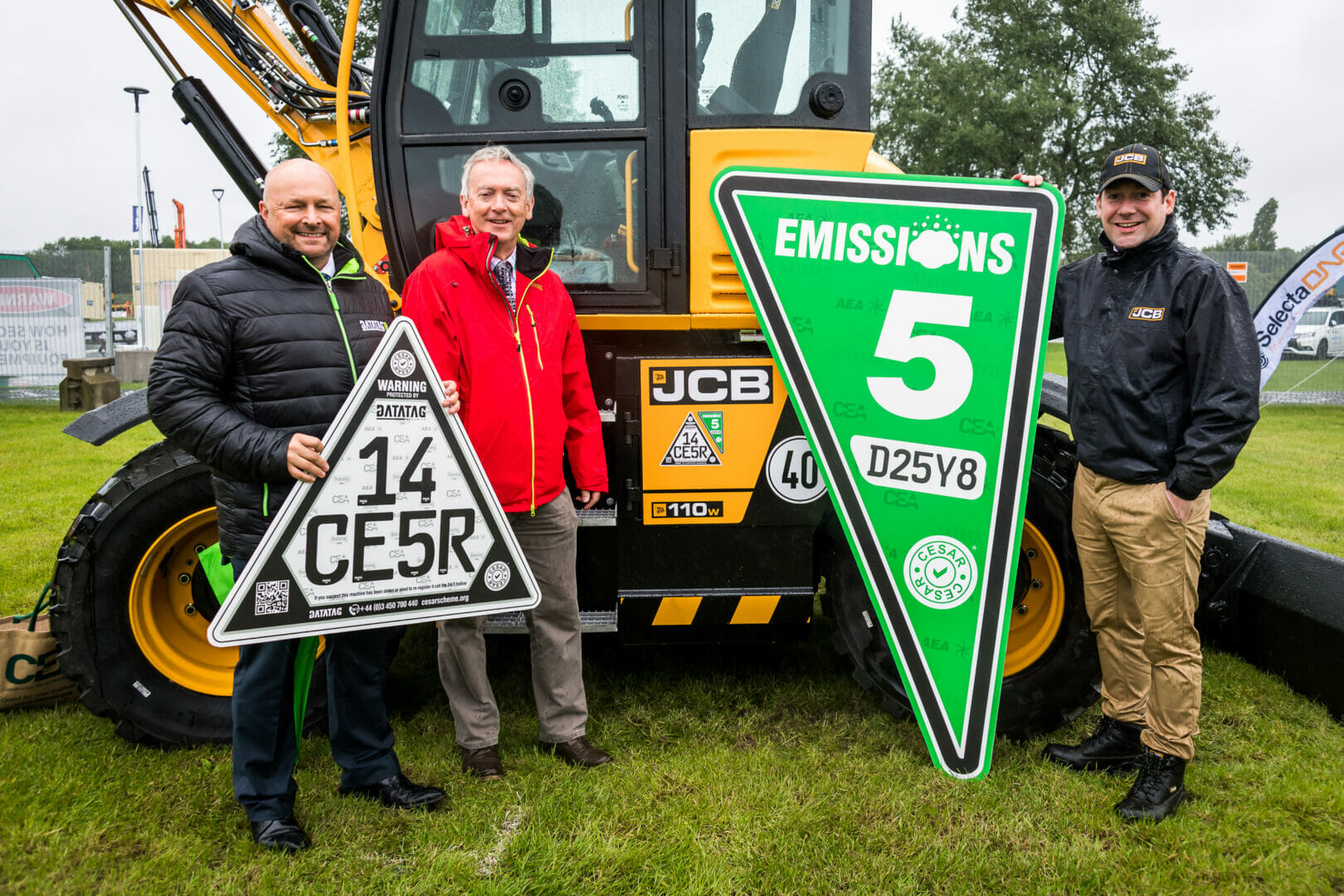
The new CESAR initiative, helping site managers and others to identify the engine emissions stage compliance of individual machines in environmentally sensitive areas, reached a milestone with the launch of the prototype ECV system at Plantworx 2019. Industry feedback on the new system is now being evaluated with a view to a full roll out later this year.
A JCB Hydradig became the first piece of construction plant to be fitted with the prototype ECV (Emissions Compliance Verification) label. Fixed alongside the standard “CESAR triangle” this new version of CESAR provides an immediate visual check on compliance backed up by a scannable QR code. The service is specifically aimed at those charged with monitoring compliance with Low Emission Zone requirements.
The initiative is being developed as a response to the demand for an easy and reliable way to confirm the emissions category of construction equipment used within Low Emission Zones and “green” construction sites.
The ECV development team are evaluating feedback from the latest round of stakeholder consultations with a view to the full launch of the scheme later this year.
Rob Oliver, Chief Executive of the CEA said, “The Emissions Compliance Verification (ECV) application for CESAR is the single biggest development since the scheme was launched as an anti-theft initiative in 2007. With the introduction of Low Emission Zones and “green” construction sites, there is an urgent demand for the quick identification of the certified emission levels of machines brought on to sites.
In developing ECV we have had some great input from HS2, the Energy Saving Trust and London boroughs, who are demanding increasingly stringent NRMM emissions standards. The mix of a secure database of machines’ vital information plus an easy to read and scan visual sticker cuts out a lot of work for construction site managers and local authorities.”
The mix of a secure database of machines’ vital information plus an easy to read and scan visual sticker cuts out a lot of work for construction site managers and local authorities. We have had some welcome feedback to our consultation process to ensure the scheme reflects industry requirements and the CESAR team are following through on all the idea, requests and comments received”.
Colin Smith, Programme Manager at Energy Saving Trust commented: “Energy Saving Trust in partnership with HS2 has helped the CEA in understanding the issues around NRMM policy and will continue to work with the project to align further label development with machinery that has been retrofitted with EST NRMM approved emission reduction systems.”
Smith added, “Knowing the air pollution impact of construction plant is key to reducing the environmental impact of construction activity, currently the only way to know if an excavator is emissions stage IIIA, IIIB, IV or V is by reading an engine plate buried somewhere in the engine bay.
To have a prominent CEA CESAR ECV label applied to the machine indicating the emissions stage backed up by a robust database will enable plant owners and operators, contractors and site managers to comply with any local policy or contractual obligation in place regarding machinery emissions level. The CEA CESAR ECV scheme has huge potential going forward, it could include data such as fuel consumption to help with GHG emissions or energy reporting and support corporate social responsibility activity. This could lead to smarter NRMM fleet management to realise cost savings and recognition of plant owners and operators taking action to reduce their environmental impact.”
Charles Stevenson, General Manager JCB commented on the new scheme he said, “JCB is leading the way in clean technology and reducing harmful emissions, especially in urban, air quality sensitive environments and enclosed spaces, so we are delighted to be the first to embrace the ECV marking and will be fitting it as standard once the scheme is fully launched later this year.”
Stevenson added, “Identifying emissions compliance with a uniform and easily recognisable symbol will bring a multitude of benefits to the customer, not least of which will be easy site access on major projects and in cities where ULEZ is enforced.”
Picture Captions:
1) The ECV is a new version of CESAR which provides an immediate visual check on compliance backed up by a scannable QR code
2) Pictured LtR Kevin Howells Datatag MD, Rob Oliver CEO CEA, and Charles Stevenson General Manager JCB launching the prototype ECV system at Plantworx 2019

